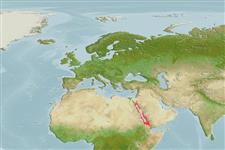Common names from other countries
>
Clupeiformes (Herrings) >
Dorosomatidae (Gizzard shads and sardinellas)
Etymology: Herklotsichthys: After Janus Adrian Herklots, Australian ichthyologist, 1820-1872.
More on author: Rüppell.
Environment: milieu / climate zone / depth range / distribution range
Ecologia
marinhas; intervalo de profundidade 0 - 50 m (Ref. 188). Subtropical; 37°N - 12°N, 29°E - 45°E (Ref. 188)
Western Indian Ocean: Red Sea and possibly Gulf of Aden; an immigrant into eastern Mediterranean Sea (Ref. 188). The names Herklotsichthys punctata and Herklotsichthys punctatus have been widely misused in the literature for another species, Herklotsichthys quadrimaculatus (Ref. 188).
Tamanho / Peso / Idade
Maturity: Lm ? range ? - ? cm
Max length : 11.7 cm TL macho/indeterminado; (Ref. 124816); common length : 9.5 cm TL macho/indeterminado; (Ref. 5450); peso máx. publicado: 15.00 g (Ref. 124816)
Descrição suscinta
Chaves de identificação | Morfologia | Morfometria
Espinhos dorsais (total) : 0; Raios dorsais (total) : 13 - 21; Espinhos anais: 0; Raios anais : 12 - 23. Flank silvery, without spots, but a series of small dark spots on back on either side of dorsal fin base or behind it.
Forms schools in coastal waters (Ref. 188). Marketed fresh, dried and dried salted or made into fish balls.
Ciclo de vida ou comportamento de acasalamento
Maturities | Reprodução | Spawnings | Egg(s) | Fecundities | Larvas
Whitehead, P.J.P., 1985. FAO Species Catalogue. Vol. 7. Clupeoid fishes of the world (suborder Clupeoidei). An annotated and illustrated catalogue of the herrings, sardines, pilchards, sprats, shads, anchovies and wolf-herrings. FAO Fish. Synop. 125(7/1):1-303. Rome: FAO. (Ref. 188)
Status na Lista Vermelha da UICN (Ref. 130435)
CITES (Ref. 128078)
Not Evaluated
Ameaça para os humanos
Harmless
Uso pelos humanos
Pescarias: pouco comercial
Ferramentas
Relatórios especiais
Baixar XML
Fontes da internet
Estimates based on models
Preferred temperature (Ref.
115969): 25.1 - 29.4, mean 28.9 (based on 54 cells).
Índice de diversidade filogenética (Ref.
82804): PD
50 = 0.5002 [Uniqueness, from 0.5 = low to 2.0 = high].
Bayesian length-weight: a=0.00912 (0.00433 - 0.01920), b=3.04 (2.87 - 3.21), in cm Total Length, based on LWR estimates for this (Sub)family-body shape (Ref.
93245).
Nível Trófico (Ref.
69278): 3.1 ±0.3 se; based on size and trophs of closest relatives
Resiliência (Ref.
120179): Elevada, tempo mínimo de duplicação da população menor que 15 meses (Preliminary K or Fecundity.).
Fishing Vulnerability (Ref.
59153): Low vulnerability (10 of 100).
